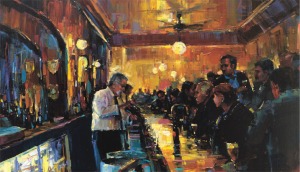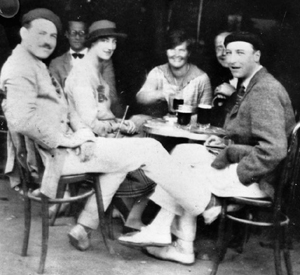Director: Cassandra Ferrell
Good morning, Ladies and Gentlemen, and thank you for coming to this pre-production meeting of The Rachel Papers. Has everyone had a chance to get coffee and donuts?….No….sorry no yogurt, but there is fruit, I think. I just wanted to give you an idea of which direction I wanted to go with this film, give you a chance to meet everyone who will be working on this project, get some input from you on how you see your characters and maybe go over several of the scenes I have in mind. You see, I feel that music underscores life. Music invokes emotion and allows the listener feel the pieces. That, along with the visual of a film, will give the audience a tactile experience allowing them to immerse themselves into a story. Since the character of Charles will be doing narration throughout the majority of the film, I decided that instrumental pieces would be appropriate to give an emotional undertone without competing with the narrations.
As you know this film will be based on a bildungsroman novel by Martin Amis set in the 1970’s; however, I wanted to …..um, yes? Bildungsroman? Bildungsroman is a “coming of age story”. Please, can we hold the questions until the end of the meeting? I wanted to take this story in a different direction. This story is going to be set in 18th century England along the lines of The History of Tom Jones: A Foundling by Henry Fielding. The costume designers are already working on spectacular pieces and we have orders powdered wigs for everyone. The costumes will be grand and spectacular with well placed plummed feathered hats and incredible jewelry. There will be so much candy for the eye to feast upon! Here is an idea of the direction the costumes will go in:
Ok, so let me introduce who you will be working with. Our Charles Highway is going to be Jesse Eisenberg.
And his Rachel and the object of his desire is going to be Allison Williams.
Chris? Is Chris here yet? Ah! Chris, I’m a big fan. Ok, Deforest will be played by the dreamy Chris Hemsworth.
And Lily Cole will play Charles’ “friends with benefits” Gloria.
Scene 1:
Ok, so now that the main characters have been introduced and everyone is acquainted let me paint you picture. The film credits open on a black background. This piece is playing as the credits role and will softly underscore the opening monologue:
The film dissolves to show a pair of hands writing with a quill and parchment. Ink well to his right. Jesse, are you right or left handed?….Ok, inkwell to his left. The camera pulls back to show Jesse or Charles is the owner of the pair of hands. It is early evening and the writing desk is by a window with the final rays of the evening sun streaming in onto the desk as the camera pans around the room. Charles stares out the window and the opening monologue voice over begins. This will be the audience’s introduction to Charles and his thought processes:
Charles: My name is Charles Highway, though you wouldn’t think it to look at me. It’s such a rangy, well-travelled, big-cocked name and, to look at, I am none of these. (flash back begins with Charles looking into a mirror inspecting each feature as the voice-over describes them.) I wear glasses for a start, have done since I was nine. And my medium-length, arseless waistless figure, corrugated ribcage and bandy legs gang up to dispel any hint of aplomb. But I have got one of those fashionable reedy voices, the ones with the habitual ironic twang, excellent for the promotion of oldster unease. And I imagine there’s something oddly daunting about my face, too. It’s angular, yet delicate; thin long nose, wide thin mouth – and the eyes: richly lashed, dark ochre with a twinkle of singed auburn….ah, how inadequate these words seems. (Amis 1-2).
Ok, here’s where the music begins to fade out and the scene is brought back to the present day with Charles sitting writing at his desk.
Scene 2:
As the narration continues, Charles continues to work on his manuscript and at pivotal points of the monologue the story will flashback. For example, when the monologue says, ‘the result being a moist four-pound waif’ the scene will flashback to the audiences first time meeting of Charles’ mother in the throes of labor with midwife standing by. A flashback will occur for every member of the family being introduced and will always return to Charles writing at his desk staring at the setting sun for a moment, looks over at the mantel clock above his fireplace and writes: Seven twenty: London on the parchment. The scene flashes back to Charles riding in a bumpy and jostling carriage trying to sleep but can’t. The score is playing:
We see Charles arrive at his sister’s house in 18th century London and retrieve his luggage as the narration continues from Charles about Jenny and Norman with this piece underscoring the flashback to Jenny and Norman’s wedding. Charles is brought out of that flashback when Norman says Gloria will be over and Jenny asks if Gloria will want dinner. When Charles say, ‘Oh no’, looks at the camera with a smirk. Scene cuts to Gloria and Charles in the middle of heated sex with the score continuing to play. A montage of varying animalistic positions of the two will continue the score. The end of the score marks the end of the sex scene. Narration begins about Gloria.
Scene 3:
Now, we’re getting to point of the film where Charles meets Rachel. We see a very affluent manor house with carriages coming and going dropping off eager guests of the ball that can be heard going on inside. The dresses are stunning and the event regal. As the camera follows Geoff and Charles into the manor house the guests are dancing a waltz in its entire splendor. The room is softly lit with massive chandeliers and dancers are spinning while dresses are twirling. This piece is playing:
After conversation with Geoff, Charles looks around the room and suddenly sees Rachel. The camera pulls in on a close up of his face as he views her and then cuts to Rachel. The music of the waltz starts to fade and become replaced by this piece that can only be heard in Charles’ mind since the dancers are still dancing to the previous waltz as Rachel’s movements are slowed by slow motions almost like a dream.
Charles seems to move unconsciously towards Rachel like a magnet pulling him towards her in slow motion. Charles stand by for a moment and waits while Rachel finishes her conversation with a few of the party guests and when Charles says “Hello”, the Debussy piece ends abruptly as the music of the waltz continues the camera resumes at normal speed.
Scene 4 – The Snogging Scene:
Now, the scene is Rachel and Charles’ first kiss. Charles has worked hard to woe Rachel over the past several weeks. Unfortunately, he has received a letter from Gloria stating that she has probably given him some sort of sexually transmitted disease. Knowing this information, Charles knows that what happens now is only going to go so far until he can address this issue. So, as Rachel is in Charles’ room they kiss for the first time. Charles is solely intent on pleasing Rachel as they begin to make out with this song underscoring the make out session.
The movements are soft and tender and both Charles and Rachel are caught up in the moment. Their scene and the music are interrupted when they hear Norman bounding down the stairs. The readjust themselves and their clothing by the time Norman throws open the door. He announces that Charles’ father has arrived and well as “His tarts’ here too!” (Amis 127) This line is the cue for this next piece which underscores the entire next scene with Charles’ father, sister, Norman and the tart which happens like a bad dream. The lines of this scene are heard by the audience but compete with the score as Charles is trying get through this uncomfortable situation as quickly as possible however time will not cooperate:
Scene 5:
Rachel is spending the weekend with Charles’ family. The scene opens with a carriage wheel, the sounds of a team of horses and this piece.
As the camera pans back from the carriage wheel to reveal the carriage at a break neck speed, the camera swings into the open window with Deforest looking out of the other side window with a pensive look on his face. Deforest arrives at Charles’ families house as Deforest bursts in to find Rachel. The camera is following his point of view as he searches the rooms of the manor house opening the door to the sitting room to find Charles and Rachel snogging. The music ends on Rachel’s line, “Deforest, what is it?” (Amis 159)
Scene 6:
This is the sex scene between Rachel and Charles. Now, at this point in the film, the viewers are already familiar with Charles’ character (or lack thereof) through his narration of events up to now. This is going to play out like a romance novel of two people engaging in the act of making love for the first time after waiting for so long. It will be romantic and thoughtful. Tender and sensual. The lighting is cast by the fireplace of Charles’ room and a candle lit on the night stand table. The score will play this piece:
However, Charles’ crude and vulgar narration will be spoken over the scene as Charles describes it in his own words giving an insight to what he is actually thinking and providing a contrast to what is actually taking place. Thus destroying a perfectly good love scene. As the sex scene ends, the scene is cut back to present day with Charles writing at his writing desk. It is evening now and the moon is shining through the window. There is a candle illuminating the manuscript and a fire in the fireplace as Charles writes:
Charles: I feel steadier now. Perhaps The Rachel Papers aren’t in such a mess after all. With some interleaving of Conquests and Techniques: A Synthesis, and an index…? When I’m twenty this will be a thing of the past. The teenage boy is entitled to a certain amount of disorder, and anyway, I’ll mellow tomorrow. (Amis 192)
Scene 7:
As Charles is writing Letter to Rachel the score plays this:
This piece underscores the writing of the letter, Rachel receiving the letter and reading it, Deforest’s carriage pulling up in front of Charles’ manor house, the final conversation between Charles and Rachel and Charles watching the carriage pull away from the manor house. The viewers do not know if Charles is heartbroken by this revelation or if he is just uncomfortable by the situation. The scene after Rachel leaves is where the movie begins with Charles sitting down at his writing desk as the evening sun is setting.
The scene cuts back to present time. It is evening and Charles looks up from his manuscript at his writing desk and out the window at the moonlit landscape. He turns and looks at the mantle clock which indicates 12:00am midnight. He gathers up his manuscript blowing on the final paper to dry the ink so not to smudge it. He files the parchment into a leather binder and ties the ribbon and places the binder on the shelf behind his bed. He pulls out a new sheet of parchment onto his writing table, returns the quill to the ink well and blows out the candle. Fade to black as this piece plays for the final credits.
Ok, Folks, that’s how things are going to progress. We start filming in two weeks so please have the first 4 or 5 scenes memorized by then. I think that’s all I have for you and thank you for coming. Any questions? No? Ok, then……. That’s a wrap!
Amis, Martin. The Rachel Papers. New York: Harmony Books, 1988. Print.













Recent Comments